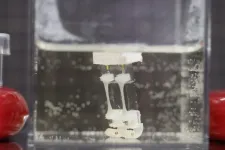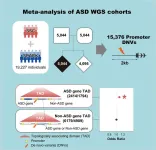(Press-News.org) In the retinas of human eyes, the cones are photoreceptor cells responsible for color vision, daylight vision, and the perception of small details. As vision scientists from the Division of Experimental Retinal Therapies at the University of Pennsylvania School of Veterinary Medicine, Gustavo D. Aguirre and William A. Beltran have been working for decades to identify the basis of inherited retinal diseases. They previously showed they could recover missing cone function by reintroducing a copy of the normal gene in photoreceptor cells.
Both humans and dogs are affected by retinal disease, and a new study of daylight vision using a canine model offers a critical insight for evaluating “whether these cell replacements—where we are introducing cones into the retinas of these dogs—is a successful approach for restoring cone vision,” says Beltran, the Corinne R. and Henry Bower Endowed Professor of Ophthalmology.
He and Gustavo Aguirre teamed with researchers including cognitive neuroscientist Geoffrey K. Aguirre, a professor of neurology at the Perelman School of Medicine, bringing together knowledge on the retinal system and brain measurements. In dogs with three different kinds of naturally occurring retinal disease and in dogs with normal vision, the scientists used functional magnetic resonance imaging (fMRI) to assess brain responses to lights that stimulate only the cone cells.
The researchers found that fMRI can detect brain responses to daylight vision for black and white information as well as color information, and it can identify the area of the visual cortex that responds to stimulation of a region in the dog retina that is rich in cones and similar to the human fovea. They also found they can use fMRI to measure the relative degree of loss of daylight vision. Using this technique in animals with a retinal disease caused by a mutation in a gene called NPHP5, they demonstrated that gene augmentation therapy restored the response in the cortex to black and white stimulation. That makes this disease a promising one in which to study photoreceptor cell replacement as a treatment in the future.
Their findings were published in Translational Vision Science & Technology. The other co-authors are Huseyin O. Taskin, a former research specialist at Penn in the GKAguirre Lab and current graduate student at the University of Toronto, and Jacqueline Wivel, a veterinary technician.
“Canine models are useful for studying retinal diseases because they have a variety of different naturally occurring genetic disorders. The ultimate goal is to first demonstrate that these disorders can be treated in canines before translating it to human patients,” says Taskin, the first author. Gustavo Aguirre says, “The hope is that successful therapeutic approaches in people will then become available to veterinarians so that they can benefit man’s four-legged friend.”
Geoffrey Aguirre says, “The purpose of the study was to see, in different versions of these retinal diseases, how much information about daylight vision makes it to the visual system in these dogs.” This knowledge is particularly useful, he says, because figuring out whether a treatment for retinal disease has been effective requires knowing how much vision function was present prior to treatment.
Beltran says this paper shows that gene therapy can recover cone function because it looks at an animal model with no cone function and shows an improvement. He explains that, in the disease caused by the NPHP5 mutation, cones are present but not functional. Animals with this disease are born day-blind but initially have some night vision, though rods—photoreceptors that allow night vision—die over a period of months, making dogs fully blind within a year.
Previous research has measured responses to stimuli through electroretinography and visual behavior tests, which Beltran says can require weeks if not months of dog training. Geoffrey Aguirre says the use of fMRI in this study is significant because it is faster and easier than measuring behavior, and it is not invasive. Taskin also notes that neither visual behavior tests nor electroretinography provide certainty as to what happens in the visual cortex.
A prior study showed that retinal gene therapy in a type of blinding disorder called Leber congential amaurosis is associated with restoration of fMRI responses from the canine visual cortex, but the nature of that study meant that both rod and cone responses could have contributed to cortical activity. The new study furthers knowledge of retinal disease by specifically stimulating the cones.
Huseyin O. Taskin is a former research specialist in the Department of Neurology at the Perelman School of Medicine and a current doctoral candidate in medical sciences at the University of Toronto.
Jacqueline Wivel is a certified veterinary technician in the University of Pennsylvania School of Veterinary Medicine.
Gustavo D. Aguirre is professor of medical genetics and ophthalmology in Penn Vet’s Department of Clinical Sciences & Advanced Medicine.
William A. Beltran is the Corinne R. and Henry Bower Endowed Professor of Ophthalmology and director of the Division of Experimental Retinal Therapies in Penn Vet’s Department of Clinical Sciences & Advanced Medicine.
Geoffrey K. Aguirre is professor of neurology, associate director of the Penn Center for Neuroscience and Society, and associate director of neurology residency in the Department of Neurology at Penn Medicine.
This study was supported by the National Eye Institute (grants R24-EY029890, RO1-EY006855, RO1-EY017549, and P30-EY001583), Fighting Blindness Canada Vision 20/20, The Foundation Fighting Blindness, and the Low Vision Research Award from the Research to Prevent Blindness / Lions Clubs 25 International Foundation.
END
Using fMRI, new vision study finds promising model for restoring cone function
School of Veterinary Medicine and Perelman School of Medicine researchers identified a retinal disease to evaluate the success of gene and cell replacement therapy.
2024-01-26
ELSE PRESS RELEASES FROM THIS DATE:
Wake Forest Institute for Regenerative Medicine awarded $160 million 10-year US National Science Foundation Regional Innovation Engines grant
2024-01-26
WINSTON-SALEM, NC, January 26, 2024 – The Wake Forest Institute for Regenerative Medicine (WFIRM) is the recipient of an inaugural U.S. National Science Foundation (NSF) Engines Program award. The NSF Engines: Piedmont Triad Regenerative Medicine Engine is a regional project that provides an innovation ecosystem to stimulate workforce development, job creation, and economic growth through the development of technologies that benefit the emerging industry. The Piedmont Triad Regenerative Medicine Engine team is led by WFIRM, and includes Forsyth Technical Community College (FTCC), North Carolina Agricultural and Technical State University (N.C. A&T), the RegenMed Development ...
Powering the future: Unlocking the role of hydrogen in lithium-ion batteries
2024-01-26
Lithium-ion batteries stand out as one of the most prevalent rechargeable battery technologies in the present era. Within these batteries, lithium-cobalt oxides (LiCoO2) are widely used as the materials for positive electrodes or cathodes (the conductors through which electric current either enters or exits a substance). The cathode plays a pivotal role in lithium-ion batteries and influences their capacity, performance over many charge-discharge cycles, and ability to manage heat.
One major issue leading to the deterioration of these batteries is the creation of hydrogen through the splitting of water. Therefore, gaining insights into how hydrogen builds ...
Scientists design a two-legged robot powered by muscle tissue
2024-01-26
Compared to robots, human bodies are flexible, capable of fine movements, and can convert energy efficiently into movement. Drawing inspiration from human gait, researchers from Japan crafted a two-legged biohybrid robot by combining muscle tissues and artificial materials. Publishing on January 26 in the journal Matter, this method allows the robot to walk and pivot.
“Research on biohybrid robots, which are a fusion of biology and mechanics, is recently attracting attention as a new field of robotics featuring biological function,” says corresponding author Shoji Takeuchi of the University of Tokyo, Japan. “Using muscle ...
Genomic “butterfly effect” explains risk for autism spectrum disorder
2024-01-26
Researchers in the RIKEN Center for Brain Science (CBS) examined the genetics of autism spectrum disorder (ASD) by analyzing mutations in the genomes of individuals and their families. They discovered that a special kind of genetic mutation works differently from typical mutations in how it contributes to the condition. In essence, because of the three-dimensional structure of the genome, mutations are able to affect neighboring genes that are linked to ASD, thus explaining why ASD can occur even without direct mutations to ASD-related genes. This study appeared in the scientific journal Cell Genomics on January 26.
ASD is a group of conditions characterized in part ...
Cultivated meat production costs could fall significantly with new cells created at Tufts University
2024-01-26
Cellular agriculture – the production of meat from cells grown in bioreactors rather than harvested from farm animals – is taking leaps in technology that are making it a more viable option for the food industry. One such leap has now been made at the Tufts University Center for Cellular Agriculture (TUCCA), led by David Kaplan, Stern Family Professor of Engineering, in which researchers have created bovine (beef) muscle cells that produce their own growth factors, a step that can significantly cut costs of production.
Growth factors, whether ...
Researchers discover why one type of chemotherapy works best in bladder cancer
2024-01-26
Tisch Cancer Institute researchers discovered that a certain type of chemotherapy improves the immune system’s ability to fight off bladder cancer, particularly when combined with immunotherapy, according to a study published in Cell Reports Medicine in January.
These findings may explain why the approach, cisplatin chemotherapy, can lead to cure in a small subset of patients with metastatic, or advanced, bladder cancer. Researchers also believe that their findings could explain why clinical trials combining another type of chemotherapy, carboplatin-based chemo, with immunotherapy have not been ...
Emergency contraception related ER visits dropped significantly over 14 year period
2024-01-26
Following federal approval for over the counter emergency contraception in 2006, emergency departments across the U.S. saw dramatic decreases in related visits and medical charges, a new study suggests.
Emergency room visits related to emergency contraception fell by 96 %, from 17,019 to 659, while total related hospital expenses decreased by $7.2 million – from $7.6 million to $385,946 – between 2006 and 2020. The most notable decrease was between 2006-2007 for people primarily seen for emergency contraception.
The Michigan Medicine led findings appear in JAMA Network ...
Job flows into and out of health care before and after the pandemic
2024-01-26
About The Study: The results of this study of approximately 18 million health care industry employees suggest a substantial and persistent increase in health care workforce turnover after the pandemic, which may have long-lasting implications for workers’ willingness to remain in health care jobs. Policymakers and health care organizations may need to act to prevent further losses of experienced staff.
Authors: Karen Shen, Ph.D., of the Johns Hopkins Bloomberg School of Public Health in Baltimore, is the corresponding ...
Incidence of fit test failure during N95 respirator reuse and extended use
2024-01-26
About The Study: In this study of 824 N95s used by 412 emergency department health care workers practicing N95 reuse, fit failure occurred in 38.7% of masks after one shift. Trifold N95s had higher incidence of fit failure compared with dome N95s. These results may inform pandemic preparedness, specifically policies related to N95 selection and reuse practices.
Authors: Ralph C. Wang, M.D., M.A.S., of the University of California, San Francisco, is the corresponding author.
To access the embargoed study: Visit our For The Media website at this link https://media.jamanetwork.com/
(doi:10.1001/jamanetworkopen.2023.53631)
Editor’s ...
Clinical risk and outpatient therapy utilization for COVID-19 in the Medicare population
2024-01-26
About The Study: In this study of patients enrolled in Medicare in 2022, those at the highest risk for severe COVID-19 infection received COVID-19 therapy less often than those with the least risk. Disparities in therapy access were found by patient age, race and ethnicity, Medicaid eligibility, and nursing home residence.
Authors: Michael L. Barnett, M.D., of the Harvard T.H. Chan School of Public Health in Boston, is the corresponding author.
To access the embargoed study: Visit our For The Media website at this link https://media.jamanetwork.com/
(doi:10.1001/jamahealthforum.2023.5044)
Editor’s ...
LAST 30 PRESS RELEASES:
Air pollution exposure and birth weight
Obstructive sleep apnea risk and mental health conditions among older adults
How talking slows eye movements behind the wheel
The Ceramic Society of Japan’s Oxoate Ceramics Research Association launches new international book project
Heart-brain connection: international study reveals the role of the vagus nerve in keeping the heart young
Researchers identify Rb1 as a predictive biomarker for a new therapeutic strategy in some breast cancers
Survey reveals ethical gaps slowing AI adoption in pediatric surgery
Stimulant ADHD medications work differently than thought
AI overestimates how smart people are, according to HSE economists
HSE researchers create genome-wide map of quadruplexes
Scientists boost cell "powerhouses" to burn more calories
Automatic label checking: The missing step in making reliable medical AI
Low daily alcohol intake linked to 50% heightened mouth cancer risk in India
American Meteorological Society announces Rick Spinrad as 2026 President-Elect
Biomass-based carbon capture spotlighted in newly released global climate webinar recording
Illuminating invisible nano pollutants: advanced bioimaging tracks the full journey of emerging nanoscale contaminants in living systems
How does age affect recovery from spinal cord injury?
Novel AI tool offers prognosis for patients with head and neck cancer
Fathers’ microplastic exposure tied to their children’s metabolic problems
Research validates laboratory model for studying high-grade serous ovarian cancer
SIR 2026 delivers transformative breakthroughs in minimally invasive medicine to improve patient care
Stem Cell Reports most downloaded papers of 2025 highlight the breadth and impact of stem cell research
Oxford-led study estimates NHS spends around 3% of its primary and secondary care budget on the health impacts of heat and cold in England
A researcher’s long quest leads to a smart composite breakthrough
Urban wild bees act as “microbial sensors” of city health.
New study finds where you live affects recovery after a hip fracture
Forecasting the impact of fully automated vehicle adoption on US road traffic injuries
Alcohol-related hospitalizations from 2016 to 2022
Semaglutide and hospitalizations in patients with obesity and established cardiovascular disease
Researchers ‘listen in’ to embryo-mother interactions during implantation using a culture system replicating the womb lining
[Press-News.org] Using fMRI, new vision study finds promising model for restoring cone functionSchool of Veterinary Medicine and Perelman School of Medicine researchers identified a retinal disease to evaluate the success of gene and cell replacement therapy.




